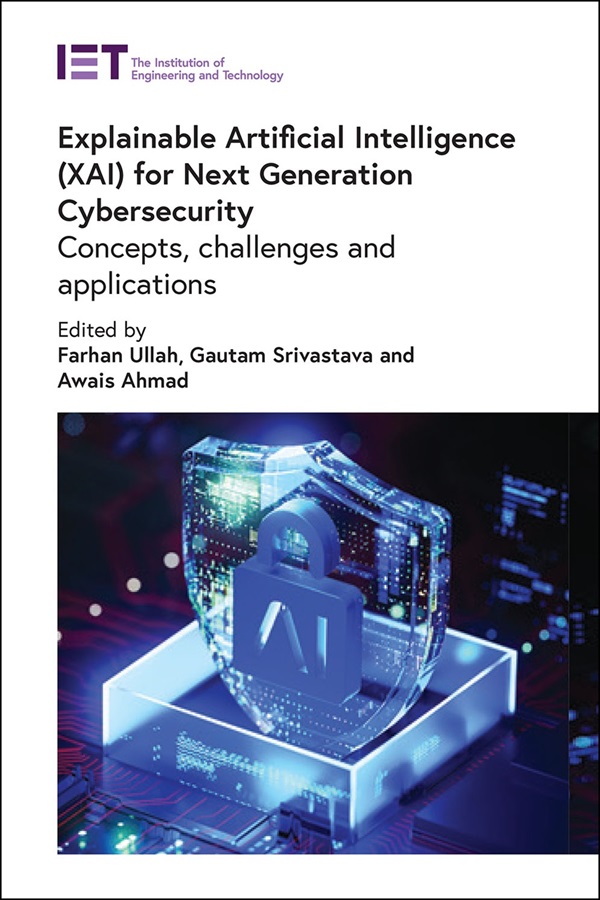- Applied Physics
- Built Environment
- Computing and Networks
- Control, Robotics and Sensors
- Electrical Regulations
- Electromagnetics and Radar
- Energy Engineering
- Healthcare Technologies
- History and Management of Technology
- IET Codes and Guidance
- Manufacturing
- Materials, Circuits and Devices
- Model Forms
- Security
- Telecommunications
- Transportation

Explainable Artificial Intelligence (XAI) for Next Generation Cybersecurity
Concepts, challenges and applications
Edited by Farhan Ullah, Gautam Srivastava, Awais Ahmad
As AI technologies progress and influence more facets of our lives, the requirement for openness and interpretability becomes increasingly important. Explainable AI (XAI) has the potential to be a paradigm shift in the next generation of AI systems. XAI strives to make AI algorithms and methods understandable by tackling trust, bias, compliance, and accountability challenges. XAI improves model disclosure, produces intrinsically interpretable deep learning approaches, offers real-time rationales, and promotes legitimate AI practice. These advances assist in the development of a more ethically sound AI ecosystem.
As the IoT evolves and supply chains become more complex, novel avenues for attack arise. The ever-changing threat landscape includes powerful adversaries such as malicious actors and hackers who are always refining their strategies, and demand ongoing monitoring and adaptive responses. Cybersecurity helps safeguard data, identify fraud, protect vital infrastructure, and ensure confidentiality. Considering the dynamic nature of the cybersecurity battlefront, a holistic approach must include pre-emptive threat intelligence, staff training, effective security tools, regular upgrades, and global collaboration. Explainable AI (XAI) explains security alerts, reduces false positives and enables faster incident response.
The objective of this book is to explore how the integration of XAI-based cybersecurity algorithms and methods support threat detection and decision-making by preserving privacy and trust, ensuring interpretability and accountability, and optimizing computational and communication costs.
This book will be a useful reference for computing and security researchers, scientists, and IT professionals in academia and industry, who are developing and designing innovative cyber threat and vulnerability detection systems and solutions, as well as advanced students and lecturers to better understand AI and XAI algorithms for cybersecurity applications.
About the Editors
Farhan Ullah is associate research professor at the Cybersecurity Center of Prince Mohammad Bin Fahd University, Saudi Arabia. He has previously held positions as associate professor at Northwestern Polytechnical University, China, visiting research fellow at the University of Camerino, Italy, and lecturer at COMSATS University Islamabad, Pakistan. He has received various awards for his research and teaching excellence. He has also been invited as a keynote speaker and has delivered courses at international conferences and summer schools. He had the privilege of contributing as a guest editor and engaging in editorial work for renowned journals such as the IEEE Journal of Biomedical and Health Informatics and KSII Transactions, among others. He has supervised several undergraduate and graduate students and served as a foreign thesis examiner for PhD theses. His work has been published in reputable journals, including those published by IEEE, Springer, Elsevier, and Wiley. His primary research areas include cybersecurity, malware analysis, data science, deep learning, and explainable AI. He received his PhD in computer science from Sichuan University, China.
Gautam Srivastava is full professor in the Department of Mathematics and Computer Science at Brandon University, Canada. He is active in the research fields of AI, cybersecurity, data mining, and big data. He has extensive guest editorial experience, including IEEE Transactions on Fuzzy Systems, IEEE Transactions on Industrial Informatics, Computer Standards and Interfaces, and Applied Stochastic Modeling and Business. He has published 400 papers in high-impact conferences and journals. His research is funded by NSERC and MITACS, and he sits on the Discovery Grant Evaluation Group for Computer Science for NSERC. He currently has active research projects with other academics in Taiwan, Singapore, Canada, and the USA. He is a senior member of the IEEE. He is an editor for top tiered journals including Information Sciences, IEEE TII, IEEE TCSS, IEEE IoT Journal, and Expert Systems. He holds a PhD degree in computer science from the University of Victoria British Columbia, Canada.
Awais Ahmad is assistant professor in the Information Systems Department, College of Computer and Information Sciences, Imam Mohammad Ibn Saud Islamic University, Riyadh, Saudi Arabia. He was previously a researcher in INTEL-NTU, National Taiwan University, Taiwan, where he was working on the Wukong Project (Smart Home). His research interests include cybersecurity, deep learning, machine learning, artificial intelligence, denoising and demosaicking, big data analytics, and Internet of Things. He has published 170+ international papers in journals including IEEE Transactions, IEEE Magazines and ACM Transactions, and at conference such as IEEE GLOBECOM, IEEE INFOCOM, IEEE LCN, and IEEE ICC. He is serving as a guest editor for several journals including Future Generation Computer Systems, Sustainable City and Societies, Computational Intelligence and Complexity, Multimedia Tools and Applications, IEEE Access, and Real-Time Image Processing Journal (Springer). He received his PhD degree in computer science and engineering from Kyungpook National University, Daegu, Korea.
Publication Year: 2025
Pages: 390
ISBN-13: 978-1-83724-031-9
Format: HBK
